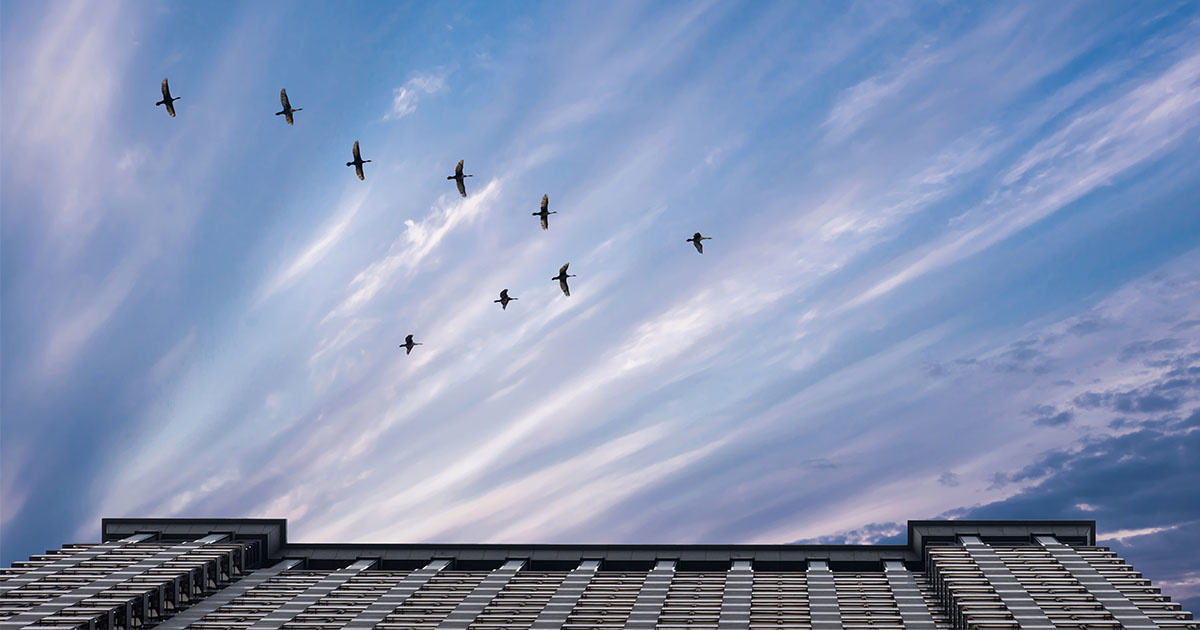

Birds flying near skyscrapers in Chicago, the most dangerous U.S. city for migrating birds. FTiare /
iStock / Getty Images Plus
What are the most dangerous U.S. cities for migratory birds?
That’s the question answered by a new study published last week in Frontiers in Ecology and the Environment, which looked at the problem of light pollution. Seventy percent of bird species present in the U.S. are migratory, and more than 80 percent of those species migrate at night. The increasing light pollution of cities attracts the avian travelers, who then crash into buildings. Building collisions kill an estimated 600 million birds in the U.S. every year, according to the Cornell Lab of Ornithology, which led the study.
The researchers created two lists for the cities that pose the greatest risk to birds during both the spring and fall migratory season, based on both geography and light pollution.
We mashed up satellite photos and weather radar to find out which cities' lights pose the greatest risk to migrating birds. Window collisions kill an estimated 599 million birds per year in the U.S. alone. See the list of cities: https://t.co/y6jv8Asupw
— Cornell Lab (@CornellBirds) April 1, 2019
Spring
- Chicago
- Houston
- Dallas
- Los Angeles
- St. Louis
- Minneapolis
- Kansas City
- New York
- Atlanta
- San Antonio
Fall
- Chicago
- Houston
- Dallas
- Atlanta
- New York
- St. Louis
- Minneapolis
- Kansas City
- Washington, DC
- Philadelphia
“Chicago, Houston, and Dallas are uniquely positioned in the heart of North America’s most trafficked aerial corridors. This, in combination with being some of the largest cities in the U.S., make them a serious threat to the passage of migrants, regardless of season,” lead study author and Rose Postdoctoral Fellow at the Cornell Lab.Kyle Horton said.
The rest of the top cities vary between fall and spring, since in the spring more birds travel through the central U.S., and a large number also travel up the West Coast. In the fall, more birds migrate along the Atlantic Coast.
“Now that we know where and when the largest numbers of migratory birds pass heavily lit areas, we can use this to help spur extra conservation efforts in these cities,” Cornell Lab Rose postdoctoral fellow and study co-author Cecilia Nilsson said.
Some conservation groups are already aware of the problem.
Chicago Bird Collision Monitors Director Annette Prince told NPR that her group finds 5,000 to 6,000 birds impacted by collision in a square-mile section of downtown Chicago every year. Sixty percent of them die on impact.
“Many of these birds are already in serious decline for other reasons,” Prince told NPR. “So when they’re hitting buildings, this is adding to the loss of the healthy members of their species by needless collision.”
Some solutions include the National Audubon Society’s Lights Out program, which encourages communities to dim their lights during peak migration season.
Lights Out! Heads up. On the nights of April 21, migratory birds and storms are on a collision course on the Upper Texas Gulf Coast. Buildings higher than two stories are encouraged to turn off unnecessary lights. https://t.co/iYQ72Uxmyp@DrBirdCast @Audubon @ABCbirds1 pic.twitter.com/OYuVtJhn2s
— Houston Audubon (@HoustonAudubon) April 21, 2018
Other ideas include constructing bird-friendly buildings with patterned glass or dimmer lights, The Guardian reported. City councils in New York and Chicago are currently considering legislation that would work bird safety into new building rules.
Horton said that individual homeowners and renters could also play a role in keeping birds safe.
“If you don’t need lights on, turn them off,” Horton said. “It’s a large-scale issue, but acting even at the very local level to reduce lighting can make a difference. While we’re hopeful that major reductions in light pollution at the city level are on the horizon, we’re excited that even small-scale actions can make a big difference.”
Big Cities, Bright Lights: Ranking the Worst Light Pollution on Earth https://t.co/e8HmrGAD77 @Greenpeace @ScienceNewsOrg
— EcoWatch (@EcoWatch) June 23, 2018

 233k
233k  41k
41k  Subscribe
Subscribe 